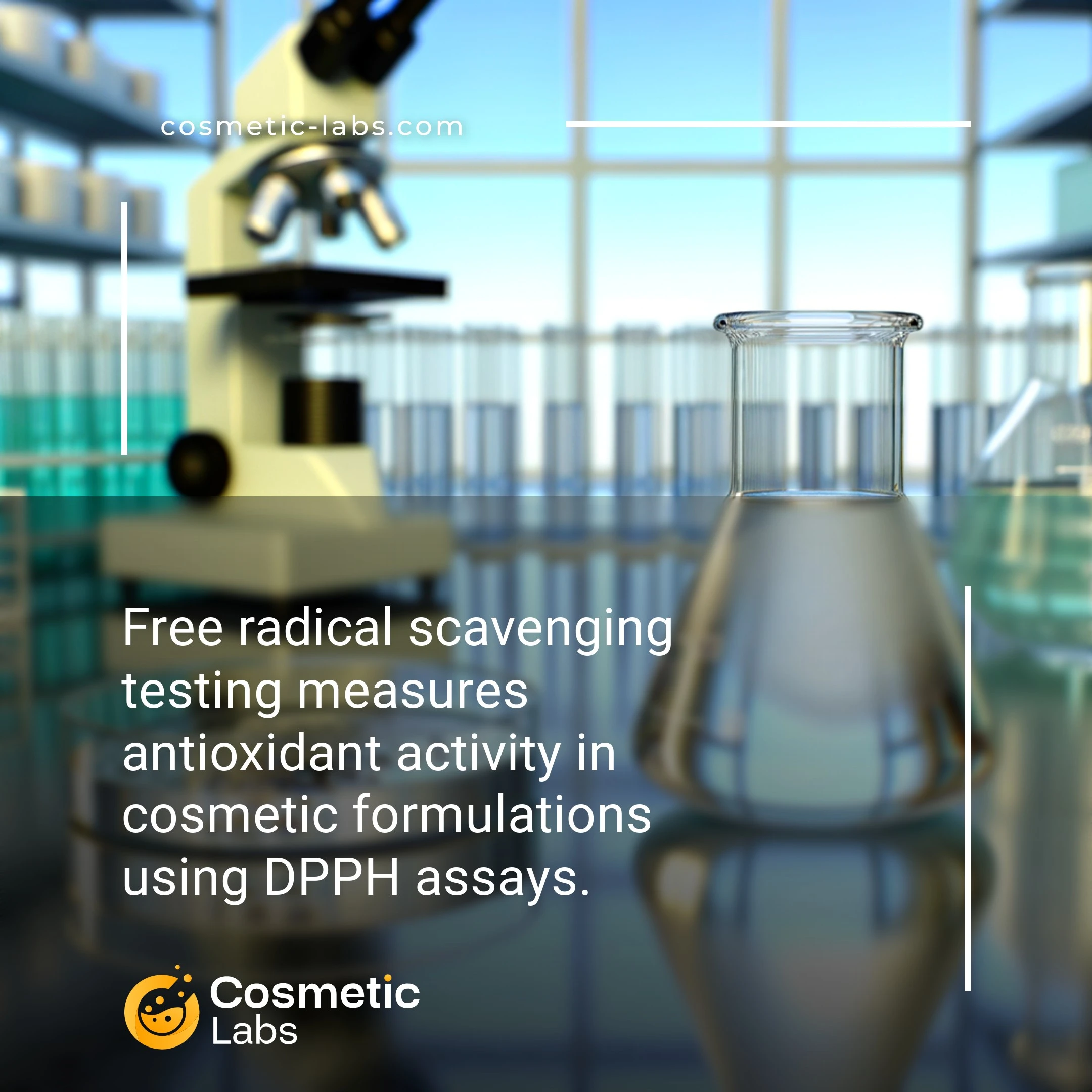Free Radical Scavenging Tests for Cosmetic Antioxidants

What is Free radical scavenging?
Free radical scavenging for oxidative stress testing is a laboratory assessment that measures how effectively cosmetic ingredients neutralize reactive oxygen species that damage skin cells. Testing methods include DPPH and ABTS assays, which quantify antioxidant capacity using spectrophotometric analysis to generate IC50 values. This data helps brands validate anti-aging claims and optimize formulations with proven protective benefits against environmental stressors.
Why do you need this service?
Cosmetic labs use free radical scavenging assays to validate antioxidant claims for anti-aging serums, sunscreens, and protective skincare formulations. These DPPH and ABTS tests measure your product’s ability to neutralize reactive oxygen species, providing quantifiable data for marketing claims and regulatory submissions while helping you optimize ingredient concentrations during formulation development.
Who provides Free radical scavenging services?
All cosmetic labs providing Free radical scavenging services
There is no company providing these services at the moment.
Free Radical Scavenging Testing for Oxidative Stress Analysis
Free radical scavenging assays measure your cosmetic ingredients’ ability to neutralize reactive oxygen species that damage skin cells. These tests provide quantitative data on antioxidant capacity, helping you validate anti-aging claims and formulate products that protect against environmental stressors.
DPPH and ABTS Scavenging Methods
Labs use standardized protocols to measure how effectively your ingredients neutralize free radicals. The DPPH assay tests radical scavenging activity against 2,2-diphenyl-1-picrylhydrazyl, while ABTS testing evaluates activity against 2,2′-azino-bis(3-ethylbenzothiazoline-6-sulfonic acid).
Key measurements include:
- IC50 values showing concentration needed for 50% radical inhibition
- Trolox equivalent antioxidant capacity (TEAC) scores
- Time-dependent scavenging kinetics
Results help you compare ingredient potency and optimize formulation ratios for maximum protective benefits.
Cellular Antioxidant Activity Testing
Cell-based assays provide more relevant data by testing how ingredients protect living cells from oxidative damage. Labs expose cultured skin cells to oxidative stressors, then measure your product’s protective effects using fluorescent markers.
This testing evaluates:
- Intracellular reactive oxygen species reduction
- Cell viability under oxidative stress conditions
- Mitochondrial function preservation
These results support efficacy claims for anti-aging formulations and help position your products against environmental damage. Contact labs on our platform to discuss specific testing protocols for your ingredients.
Practical Applications of Free Radical Scavenging Testing Services
Cosmetic labs use free radical scavenging assays for oxidative stress testing to validate antioxidant claims and demonstrate product efficacy across multiple beauty categories.
Anti-Aging Product Development
Labs measure DPPH radical scavenging activity and ABTS assays to quantify antioxidant capacity in serums, creams, and treatments. These tests reveal how effectively ingredients like vitamin C, resveratrol, and botanical extracts neutralize reactive oxygen species that cause skin aging.
Testing protocols typically run 24-72 hours with IC50 values providing precise antioxidant potency measurements. Results support marketing claims about wrinkle reduction and skin protection while meeting regulatory requirements for efficacy substantiation.
| Assay Type | Testing Duration | Key Measurement | Product Application |
|---|---|---|---|
| DPPH Scavenging | 30 minutes – 2 hours | IC50 concentration | Anti-aging serums |
| ABTS Radical Assay | 6-10 minutes | TEAC values | Protective creams |
| ORAC Testing | 35 minutes | Oxygen radical capacity | Antioxidant supplements |
Sun Care and Environmental Protection
Brands developing sunscreens and daily moisturizers rely on oxidative stress testing to validate protection against UV-induced free radical damage. Labs perform hydroxyl radical scavenging assays alongside photostability testing to demonstrate comprehensive skin defense.
These services help formulate products that combine physical UV filters with antioxidant actives like zinc oxide and green tea extract. Testing data supports SPF claims while proving additional antioxidant benefits beyond basic sun protection.
Ready to validate your product’s antioxidant performance? Connect with experienced cosmetic labs on our platform to discuss your free radical scavenging testing requirements and timeline.
